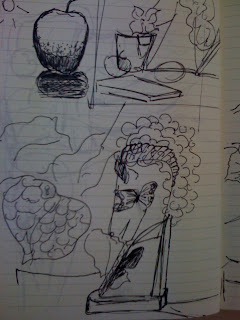In this project, we are to use different photographs taken with panorama technique to create a whole or a part of the composition. From there, use paint to finish the project. The goal is to create visual hiccups to the viewers. We are not going to try to imitate the photographs or hide the fact that photos are glued underneath or used as part of the composition.
Before working on this project, we got a chance to see the work of Luke Buchanan and hear him talk about the process. It amazed me how he can use the colors and the paint so effectively with photographs and be able to tell an interesting story.
“The painting as a sum of all parts becomes both literal and symbolic”
—Luke Buchanan
The process of this project follows these steps:
- Take photos of the location/object using panorama style. I took more than 100 photos to make sure that I have every details needed for my project. By the end, I only used 6 of them. The extra photos did not go to waste because I can use them for different approach to the same subject if I want to paint again.
- Glue down the photos using gel medium. Since I used a very thin photo paper, they end up being really wrinkle and easy to be ripped. I was worried a little that I almost teared them down to re-glue everything.
- Paint in really thin layers to see different layers of colors. I was really happy before I started because painting thinly IS my strength. I always like the water color effect and unconsciously create that effect using any kind of material. The truth is never pretty. Oil and I are not best friends!
- Finish up!
Glued photos. The wrinkles actually create really nice effects of the rusted and woody look of the house. It brings out the old and abandon feeling for the place. We’ve got to love lucky accidents!
I accidentally painted on the photos but my professor caught it! She told me to wipe everything off so that I can take advantage of the photos! I HATE wiping off things. Just like in design, I avoid using UNDO and avoid erasing in drawing. I’m glad I wiped the paint off though because now I don’t have to worry about how to re-create the whole scene.
More layers of paint. I like to plan ahead my painting by either sketching or playing on the computer. In this project, I lay the photographs the way I liked in photoshop, measured the dimension for the support and print of a few copies of this composition. From there, I used color pencil to play with different color palettes until I felt happy. In this case, I kept the color true to the photographs.
By the end of that class work time, I was able to block in the whole painting. I was even able to finish the right side of the painting that I was really satisfied. It was my most favorite spot on this painting.
I had only an hour to work on in class that day because we were about to go to the Art Museum as a whole class. After discussing with my professor, I learned that I could play with the light temperature between the inside and outside, how to play with light to dark to pull the perspective. I blocked some more paint for the ceiling and made a wide range of shades for the floor. I also blocked the sky so that I can have a better visual. Still undecided of what to create for the ceiling and how to connect the inside with outside without making the painting too weird! Pencil color is soo much easier than painting oil! Oh and by the way, that photo is of my painting and the head of my professor.
Here is the semi-final version! Please excuse the glare from the sun on the really dark corners. I worked on the ceiling and the sky more. I also refined the shadow of the handle. Trees are touched up. I was rushing because I had about an hour to turn in everything for this class and other classes. Somehow I pulled it off. Magic does happen I guess!
Here are some of the closed up shots. If you look really closely, you will see where the photos end and where the painting starts.
I did a few last touch up on the ground so that there is no more bright spots and make the tree to the far left more airy looking! I am still not too happy about that tree...more touch up during the summer? Thoughts?
This painting breaks all of my records in terms of timing. I had the idea right away, the photos were ready and the painting were done in less than 3 class sessions (about 8-9 hours). A lot of students did not choose the architecture topics because they did not want to “imitate” Luke Buchanan’s style. I want to see how different artists can interpret the same subject matter using the same techniques. Of course, I am not as experienced as Luke but I am sure with more practice, I will get better. I really enjoyed this and I think it is the project that I am able to use all I have learned in class:
- Directional strokes
- Color temperature
- Painting light
- The use of different brush
- Mixing colors
- Using different materials instead of only paint
- Wipe off my paint!!!
- Scrape paint off!!!!
It is a nice way to end my painting class? And my college career! I am graduating in 3 days you all!








































